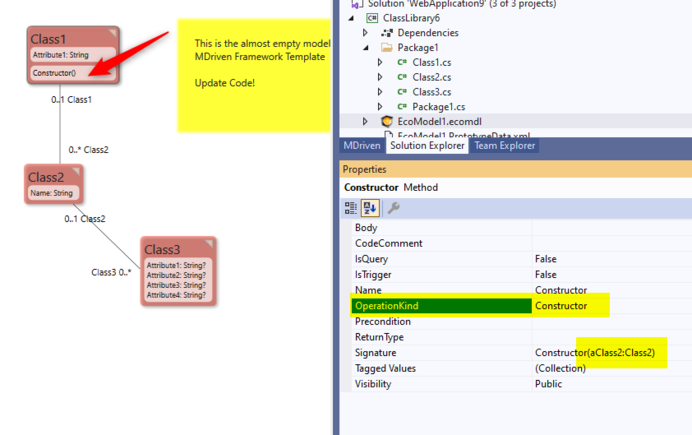No edit summary |
No edit summary |
||
| (11 intermediate revisions by 4 users not shown) | |||
| Line 1: | Line 1: | ||
<message>Write the content here to display this box</message> | |||
There are different kinds of operation methods: | |||
[[File:2021-10-14 18h31 05.png|none|thumb]] | [[File:2021-10-14 18h31 05.png|none|thumb]] | ||
[[File:2021-10-14 18h27 52.png|none|thumb|692x692px]] | [[File:2021-10-14 18h27 52.png|none|thumb|692x692px]] | ||
To create a constructor | To create a constructor, first, add a normal method, then change the <code><span class="col-black">'''operationKind'''</span></code> to constructor. | ||
In generated code you will get this: | In generated code, you will get this: | ||
public partial class Class1 | public partial class Class1 | ||
{ | { | ||
| Line 13: | Line 14: | ||
} | } | ||
Normally when doing a constructor for "live" objects you will want to send in IEcoServiceProvider and call the main constructor we provide like this: | Normally, when doing a constructor for "live" objects, you will want to send in IEcoServiceProvider and call the main constructor we provide like this: | ||
public Class1(IEcoServiceProvider serviceProvider, Class2 aClass2): this(serviceProvider) | public Class1(IEcoServiceProvider serviceProvider, Class2 aClass2): this(serviceProvider) | ||
{ | { | ||
} | } | ||
[[Category:MDriven Framework]] | [[Category:MDriven Framework]] | ||
=== When not using code - only action language === | |||
When not using code - only action language (EAL) we do not allow for constructors being implemented in the body property of the method. You can however set OperationKind:Static and go like this: | |||
SimulatedConstructor(input1:String; input2:String):Class1 | |||
And in the body: | |||
let ret=Class1.Create in( | |||
ret.Attribute1:=input1; | |||
ret.Attribute2:=input2; | |||
ret ) | |||
All in all this will serve the same effect as a constructor - when you need to set provided parameters or create structures in one go call it with: | |||
Class1.SimulatedConstructor('a','b') | |||
{{Edited|July|12|2025}} | |||
Latest revision as of 05:08, 23 April 2025
There are different kinds of operation methods:
To create a constructor, first, add a normal method, then change the operationKind to constructor.
In generated code, you will get this:
public partial class Class1
{
[UmlElement(Id = "c8111515-b7a5-4b9b-87f9-4a19261c8bd8")]
public Class1(Class2 aClass2)
{
}
}
Normally, when doing a constructor for "live" objects, you will want to send in IEcoServiceProvider and call the main constructor we provide like this:
public Class1(IEcoServiceProvider serviceProvider, Class2 aClass2): this(serviceProvider)
{
}
When not using code - only action language
When not using code - only action language (EAL) we do not allow for constructors being implemented in the body property of the method. You can however set OperationKind:Static and go like this:
SimulatedConstructor(input1:String; input2:String):Class1
And in the body:
let ret=Class1.Create in( ret.Attribute1:=input1; ret.Attribute2:=input2; ret )
All in all this will serve the same effect as a constructor - when you need to set provided parameters or create structures in one go call it with:
Class1.SimulatedConstructor('a','b')


